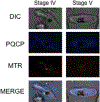Synthesis, characterization, and cellular localization of a fluorescent probe of the antimalarial 8-aminoquinoline primaquine
- PMID: 28939120
- PMCID: PMC6311391
- DOI: 10.1016/j.bmcl.2017.09.030
Synthesis, characterization, and cellular localization of a fluorescent probe of the antimalarial 8-aminoquinoline primaquine
Abstract
Primaquine (PQ) is the only commercially available drug that clears dormant liver stages of malaria and blocks transmission to mosquito vectors. Although an old drug, much remains to be known about the mechanism(s) of action. Herein we develop a fluorescent tagged PQ to discover cellular localization in the human malaria parasite, Plasmodium falciparum. Successful synthesis and characterization of a primaquine-coumarin fluorescent probe (PQCP) demonstrated potency equivalent to the parent drug and the probe was not cytotoxic to HepG2 carcinoma cells. Cellular localization was found primarily in the cytosol of the asexual erythrocytic and gametocyte stages of parasite development.
Keywords: 8-Aminoquinoline; Fluorescent probe; Malaria; Plasmodium falciparum; Primaquine.
Copyright © 2017 Elsevier Ltd. All rights reserved.
Figures






Similar articles
-
Machine learning prioritizes synthesis of primaquine ureidoamides with high antimalarial activity and attenuated cytotoxicity.Eur J Med Chem. 2018 Feb 25;146:651-667. doi: 10.1016/j.ejmech.2018.01.062. Epub 2018 Jan 31. Eur J Med Chem. 2018. PMID: 29407988
-
PFMDR1 POLYMORPHISMS INFLUENCE ON IN VITRO SENSITIVITY OF THAI PLASMODIUM FALCIPARUM ISOLATES TO PRIMAQUINE, SITAMAQUINE AND TAFENOQUINE.Southeast Asian J Trop Med Public Health. 2016 May;47(3):366-76. Southeast Asian J Trop Med Public Health. 2016. PMID: 27405118
-
Antimalarial activity of primaquine operates via a two-step biochemical relay.Nat Commun. 2019 Jul 19;10(1):3226. doi: 10.1038/s41467-019-11239-0. Nat Commun. 2019. PMID: 31324806 Free PMC article.
-
Plasmodium falciparum gametocytes: with a view to a kill.Parasitology. 2013 Dec;140(14):1718-34. doi: 10.1017/S0031182013001236. Epub 2013 Aug 19. Parasitology. 2013. PMID: 23953486 Review.
-
[Role of primaquine in malaria control and elimination in French-speaking Africa].Bull Soc Pathol Exot. 2017 Aug;110(3):198-206. doi: 10.1007/s13149-017-0556-z. Epub 2017 Apr 17. Bull Soc Pathol Exot. 2017. PMID: 28417346 Review. French.
Cited by
-
Pan-active imidazolopiperazine antimalarials target the Plasmodium falciparum intracellular secretory pathway.Nat Commun. 2020 Apr 14;11(1):1780. doi: 10.1038/s41467-020-15440-4. Nat Commun. 2020. PMID: 32286267 Free PMC article.
References
-
- CDC Malaria Disease Facts; 2015. https://www.cdc.gov/malaria/about/disease.html.
MeSH terms
Substances
Grants and funding
LinkOut - more resources
Full Text Sources
Other Literature Sources

